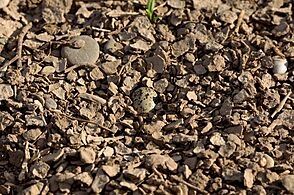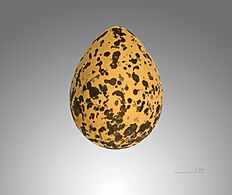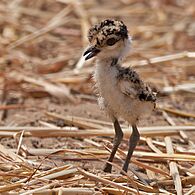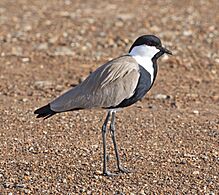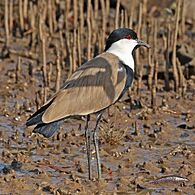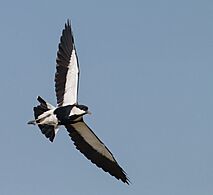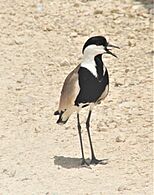Spur-winged lapwing facts for kids
Quick facts for kids Spur-winged lapwing |
|
|---|---|
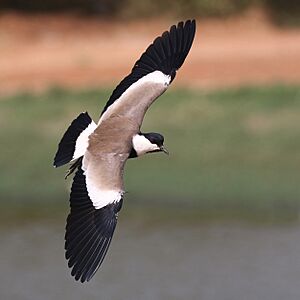 |
|
| Upper side of wings - note the spurs on the leading edge of the carpal joint | |
| Conservation status | |
| Scientific classification | |
| Genus: |
Vanellus
|
| Species: |
spinosus
|
| Synonyms | |
|
Charadrius spinosus Linnaeus, 1758 |
|
The spur-winged lapwing (Vanellus spinosus) is a cool bird that lives near water. It's a type of lapwing, which are medium-sized waders. Waders are birds that often walk in shallow water to find food. This bird is easy to spot because of its unique look and loud calls.
Contents
Naming the Spur-winged Lapwing
Scientists give every animal a special name. This helps everyone around the world know exactly which animal they are talking about. The spur-winged lapwing got its scientific name, Vanellus spinosus, from a Swedish scientist named Carl Linnaeus in 1758. He was famous for creating the system we still use today to name living things. The word "spinosus" comes from Latin and means "thorny," which refers to the small spur on its wing.
What Does It Look Like?
These birds are easy to notice! They are medium-sized with a black head, chest, and tail. Their face, neck, and belly are white. Their wings and back are light brown. Both their beak and legs are black.
You can also hear them easily because they make a loud sound that sounds like "did-he-do-it." The bird's name comes from a small, hidden claw or spur on each of its wings.
Where Do Spur-winged Lapwings Live?
Spur-winged lapwings live around the eastern Mediterranean Sea. They also live in a wide area from west Africa (south of the Sahara Desert) all the way to Arabia.
Some of these birds, like those in Greece and Turkey, fly to different places for winter. This is called migration. Other groups of these birds stay in the same place all year. While their numbers are going down in some northern areas, they are still very common in many parts of tropical Africa. You can often see them near almost any wetland there.
This bird is also part of an agreement to protect birds that migrate between Africa and Europe. In eastern and southern Africa, these birds have been spreading to new areas. They were first seen in Zambia in 1999 and have been moving further south and west since then.
Life and Habits
These birds love to live in marshes and other similar freshwater places. They find their food, like insects and other small creatures, by picking them off the ground.
Reproduction and Protecting Chicks
Female spur-winged lapwings lay about four yellowish eggs with spots. They make a simple nest on the ground. These birds are known to use the small spurs on their wings to protect their babies. If animals, or even people, get too close to their young, the lapwings might try to scare them away using these wing-claws.
The Crocodile Bird Story
For a long time, there was a story from an ancient Greek writer named Herodotus. He wrote about a bird, which some thought was the spur-winged lapwing, that would clean the teeth of Nile crocodiles. This idea is called a "cleaning symbiosis," where two different animals help each other.
However, scientists today don't have strong proof that this bird, or any other bird, actually cleans crocodile teeth. While spur-winged lapwings are often seen near crocodiles basking in the sun, and the crocodiles seem to tolerate them, there's no clear evidence of them cleaning teeth.
Images for kids
-
A spur-winged lapwing in the Gambia



